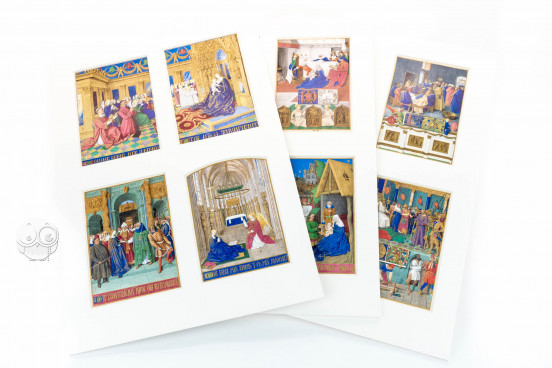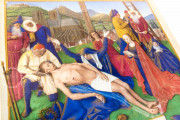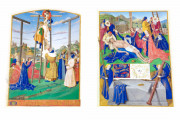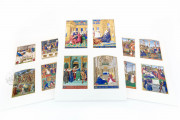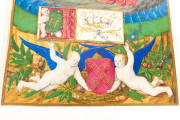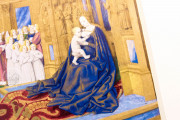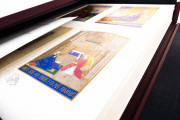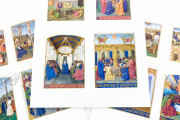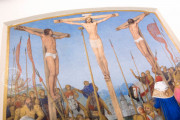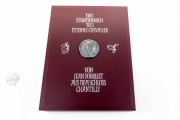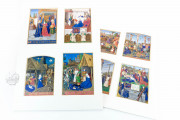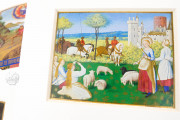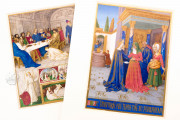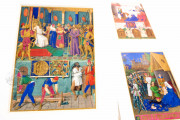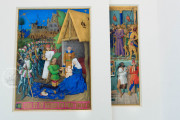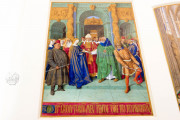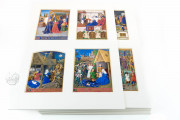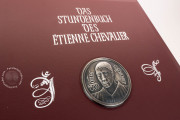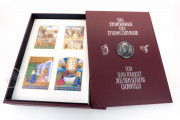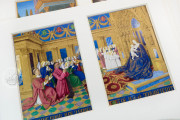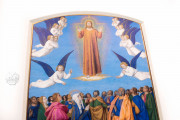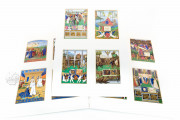The magnificent Christian prayer book known as the Hours of Étienne Chevalier, commissioned by the eponymous Treasurer of France under King Charles VII, survives in forty-nine leaves and cuttings after being dismembered in the eighteenth century. Painted by Jean Fouquet in Tours between 1452 and 1460, the extant miniatures are emblematic of the artist's ability to reimagine and render in detail well-known subjects from the lives of the Virgin Mary and Christ in a new light, as well as the contemporary interest in depicting interiors and architecture.
The destiny of the Book of Hours of Étienne Chevalier remains obscure to this day. What is well known, however, is the man who commissioned the work: Étienne Chevalier, Treasurer of France under the reign of King Charles VII (1422-1461).
The masterpiece may have remained in his family until the last descendant of Étienne: Nicolas Chevalier, Baron of Crissé (1562–1630). Following this, the trail goes cold until the end of the 17th century, when the scholar and antiquarian Roger de Gaignières located the intact manuscript.
The Hours of Étienne Chevalier, dismembered for its outstanding quality
It is entirely probable that the exceptionally high quality of the miniatures ultimately signaled the work’s doom, because some time after it came into the possession of de Gaignières, the manuscript was broken up and a total of 40 miniatures were mounted on panels.
During the chaos of the French Revolution, the series ended up in the hands of the Belgian art dealer, Peter Birmannand, then passed into the ownership of the banker Georg Brentano, from Frankfurt.
The 40 miniatures finally succeeded in returning to their native France in 1891, when the scholar Émile Picot accomplished their purchase on behalf of the Duke of Aumale, for the considerable sum of 250,000 Francs. Since then, the 40 “pictures” from the Hours of Étienne Chevalier have been exhibited in the Château de Chantilly, in the Santuario, a special room adapted by the Duke for just this purpose.
Jean Fouquet: innovation in style
For centuries, the cycle of miniatures from Chantilly was merely considered a sequence of images depicting the life of Christ, complemented by scenes from the Old Testament.
It was only in the ‘70s that a systemic study of the Hours of Étienne Chevalier in their broader context developed the understanding that each miniature is closely related to the hymn text of the respective office. The discovery of 7 further miniatures granted the opportunity for a more comprehensive study of the cycle in its entirety.
Each of the 47 miniatures is a world in its own right. With his distinct and innovative style, Jean Fouquet manifests a sublime inspiration: he reinterprets commonly used scenes, yet in an unprecedented way – some are familiar to the eyes of his contemporaries, and others rarely used. To the same extent, Fouquet introduces elements that are inspired by current events and the life of his time.
Due to their unique conception, the miniatures appear as actual paintings – and yet the delicately finished images fit in the golden frames, richly decorated with floral elements. Jean Fouquet succeeded in getting the most out of the limited space available in order to foreground the statement conceived by his artistic vision; and also by using the space reserved for the initials and the first lines of text.
Surviving known folios from the Hours of Étienne Chevalier
Musée Condé - Chantilly
- Saint John on Patmos (Gospel of John)
- Adoration of the Magi (Gospel of Matthew)
- Ascension (Gospel of Mark)
- Étienne Chevalier praying before the Virgin (Office of the Virgin, Matins)
- Visitation (Office of the Virgin, Lauds)
- Arrest of Christ (Office of the Cross, matins)
- Annunciation (Office of the Holy Spirit, matins)
- Nativity (Office of the Virgin, prime)
- Jesus before Pilate (Office of the Cross, prime)
- Announcement of the Virgin's Death (Office of the Virgin, terce)
- Christ carrying the cross (Office of the Cross, terce)
- Pentecost (Office of the Holy Spirit, terce)
- Dormition (Office of the Virgin, sext)
- Funeral of the Virgin (Office of the Virgin, nones)
- Crucifixion (Office of the Cross, nones)
- Fountain of the apostles (Office of the Holy Spirit, nones)
- Assumption (Office of the Virgin, vespers)
- Descent from the Cross (Office of the Cross, vespers)
- Coronation of the Virgin (Office of the Virgin, compline)
- Anointing of Christ (Office of the Cross, compline)
- The Holy Spirit illuminating the faithful (Office of the Holy Spirit, compline)
- Marriage of the Virgin (Office of the Virgin for Advent)
- Funeral scenes (Offices of the Dead, Vespers)
- Job and his Friends (Office of the Dead, Vigiles)
- Pietà (Hymns of the Stabat Mater)
- Saint Bernard (Poem by Saint Bernard)
- Birth of John the Baptist (Suffrage)
- Saint John the Evangelist and the Wedding at Cana (Suffrage)
- Martyrdom of Saint Peter (Suffrage)
- Conversion of Saint Paul (Suffrage)
- Martyrdom of Saint Andrew (Suffrage)
- Martyrdom of Saint James (Suffrage)
- Martyrdom of Saint Stephen (Suffrage)
- Saint Nicolas consecrated (Suffrage)
- Saint Hilary at the council of Pope Leo I (Suffrage)
- Saint Mary Magdalene anointing Christ's feet (Suffrage)
- Martyrdom of Saint Catherine (Suffrage)
- Martyrdom of Saint Appoline (Suffrage)
- All the saints, the Virgin and the Trinity (Suffrage)
Other repositories
- Bibliothèque Nationale de France, n.a. lat. 1416: Saint Anne and the three Maries
- British Library, Add. 37421: David at prayer (Psalms)
- Musée du Louvre, département des arts graphiques, R.F. 1679: Saint Margaret and Olibrius (Suffrage) and Charity of Saint Martin (Suffrage)
- Musée Marmottan-Monet: Miracle of Saint Vrain (Suffrage)
- Upton House, Bearsted Collection: Saint Michael fighting the dragon (Suffrage)
- Metropolitan Museum of Art, Lehman Collection: Right hand of God driving out demons (Office of the Holy Spirit, vêpre)
- Collection of Roger and Alix De Kesel Deurle: Double page of text (psalms 129 and 142, and litanies)
We have 1 facsimile edition of the manuscript "Hours of Étienne Chevalier": Stundenbuch des Étienne Chevalier facsimile edition, published by Mueller & Schindler, 2015
Request Info / Price
